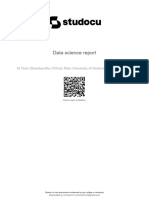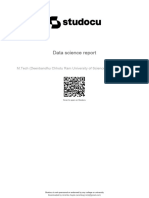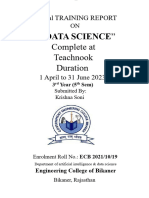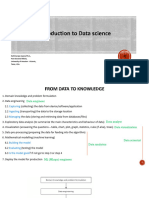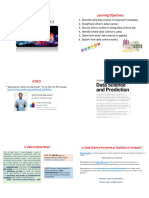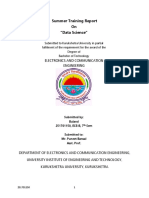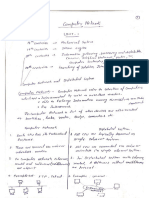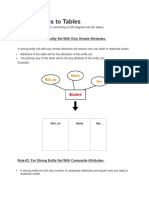0 ratings0% found this document useful (0 votes)
64 views27 pagesFile
Uploaded by
Harsh OjhaCopyright
© © All Rights Reserved
We take content rights seriously. If you suspect this is your content, claim it here.
Available Formats
Download as PDF or read online on Scribd
0 ratings0% found this document useful (0 votes)
64 views27 pagesFile
Uploaded by
Harsh OjhaCopyright
© © All Rights Reserved
We take content rights seriously. If you suspect this is your content, claim it here.
Available Formats
Download as PDF or read online on Scribd
You are on page 1/ 27
ACKNOWLEDGEMENT
The work in this report is an outcome of continuous work over a period and
drew intellectual support from Internshala and other sources. I would like to
articulate our profound gratitude and indebtedness to Internshala helped us
in completion of the training, I am thankful to Internshala Training Associates for
teaching and assisting me in making the training successful.
Mayank
18001004030
MED, 7" Sem
DCRUST MURTHAL
Downloades by Harsh Oha (hoa
1. ABOUT TRAINING
+ NAME OF TRAINING: DATA SCIENCE
+ HOSTING INSTITUTION: INTERNSHALA
* DATES: From 1* July 2021 to 12% August 2021
2. ABOUT INTERNSHALA
Internshala is an internship and online training platform, based in Gurgaon, India, Founded in
2011 by Sarvesh Agrawal, an IIT Madras alumni. The site offers searching and posting
internships, and other career services such as counselling, cover-letter writing, resume building
and training programs to students.
3. OBJECTIVES
To explore, sort and analyse mega data from various sources to take advantage of them and
reach conclusions to optimize business processes and for decision support.
Examples include machine maintenance or (predictive maintenance), in the fields of marketing
and sales with sales forecasting based on weather
4. DATA SCIENCE
Data Science as a multi-disciplinary subject that uses mathematics, statistics, and computer
science to study and evaluate data. The key objective of Data Science is to extract valuable
information for use in strategic decision making, product development, trend analysis, and
forecasting.
Data Science concepts and proc
programming, social engineering, data warehousing, machine learning, and natural language
processing. The key techniques in use are data mining, big data analysis, data extraction and
data retrieval.
s are mostly derived from data engineering, statistics,
Data science is the field of study that combines domain expertise, programming skills, and
knowledge of mathematics and statistics to extract meaningful insights from data. Data science
practitioners apply machine leaming algorithms to numbers, text, images, video, audio, and
more to produce artificial intelligence (AI) systems to perform tasks that ordinarily require
DDownloades by Harsh Oha hoinats2
human intelligence. In tur, these systems generate insights which analysts and business users
can translate into tangible business value.
DATA SCIENCE PROCESS:
1. The first step of this process is setting a research goal. The main purpose here is making
sure all the stakeholders understand the what, how, and why of the project.
2. The second phase is data retrieval. You want to have data available for analysis, so this
step includes finding suitable data and getting access to the data from the data owner. The
result is data in its raw form, which probably needs polishing and transformation before
it becomes usable.
3. Now that you have the raw data, it’s time to prepare it. This includes transforming the
data from a raw form into data that’s directly usable in your models. To achieve this,
you'll detect and correct different kinds of errors in the data, combine data from different
data sources, and transform it. If you have successfully completed this step, you can
progress to data visualization and modeling.
4. The fourth step is data exploration. The goal of this step is to gain a deep understanding
of the data. You'll look for patterns, correlations, and deviations based on visual and
descriptive techniques. The insights you gain from this phase will enable you to start
modeling.
5. Finally, we get to the sexiest part: model building (often referred to as “data modeling”
throughout this book). It is now that you attempt to gain the insights or make the
predictions stated in your project charter. Now is the time to bring out the heavy guns,
but remember research has taught us that often (but not always) a combination of simple
models tends to outperform one complicated model. If you've done this phase right,
you're almost done.
6. The last step of the data science model is presenting your results and automating the
analysis, if needed. One goal of a project is to change a process and/or make better
decisions. You may still need to convince the business that your findings will indeed
change the business process as expected. This is where you can shine in your influencer
role, The importance of this step is more apparent in projects on a strategic and tactical
level. Certain projects require you to perform the business process over and over again,
so automating the project will save time.
5. MY LEARNINGS
E
1) INTRODUCTION TO DATA SCIEN
+ Overview & Terminologies in Data Science
+ Applications of Data Science
» Unfamiliar detection (fraud, disease, etc.)
Downloaded by Harsh Ojha(hojhat52002@gma.com)
v
Automation and decision-making (credit worthiness, ete.)
Classifications (classifying emails a
“important” or “junk”)
Forecasting (sales, revenue, ete.)
Pattern detection (weather patterns, financial market patterns, etc.)
vvvyv
Recognition (facial, voice, text, etc.)
v
Recommendations (based on leamed preferences, recommendation engines can
refer you to movies, restaurants and books you may like)
2) PYTHON FOR DATA SCIENCE
Introduction to Python, Understanding Operators, Variables and Data Types, Conditional
Statements, Looping Constructs, Functions, Data Structure, Lists, Dictionaries, Understanding
Standard Libraries in Python, reading a CSV File in Python, Data Frames and basic operations
with Data Frames, Indexing Data Frame.
3) UNDERSTANDING THE STATISTICS FOR DATA SCIENCE
Introduction to Statistics, Measures of Central Tendency, Understanding the spread of data,
Data Distribution, Introduction to Probability, Probabilities of Discrete and Continuous
Variables, Normal Distribution, Introduction to Inferential Statistics, Understanding the
Confidence Interval and margin of error, Hypothesis Testing, Various Tests, Correlation.
4) PREDICTIVE MODELING AND BASICS OF MACHINE LEARNING
Introduction to Predictive Modeling, Types and Stages of Predictive Models, Hypothesis
Generation, Data Extraction and Exploration, Variable Identification, Univariate Analysis for
Continuous Variables and Categorical Variables, Bivariate Analysis, Treating Missing Values
and Outliers, Transforming the Variables, Basics of Model Building, Linear and Logistic
Regression, Decision Trees, K-means Algorithms in Python.
Summary of Procedure of Analyzing Data:
Data science generally has a five-stage life cycle that consists of:
+ Capture: data entry, signal reception, data extraction
+ Maintain: Data cleansing, data staging, data processing.
+ Process: Data mining, clustering/classification, data modelling
+ Communicate; Data reporting, data visualization
+ Analyse: Predictive analysis, regression
Downloaded by Harsh Oha (hoinats2
Introduction to Data Science
Data Science
‘The field of bringing insights from data using scientific techniques is called data setence.
Applications
Amazon Go — No checkout lines
Computer Vision - The advancement in recognizing an image by a computer involves processing large sets
of image data from multiple objects of same category. For example, Face recognition.
Spectrum of Business Analysis
4
What can happen?
Given data is
collected and used.
Big Data
What is likely to
happen?
2 Predictive Analysis
e ’
E What's happening
3 now?
Dashboards
Why did it
happen?
Detective Analysis
‘What happened?
Reporting
—
1 Value added to organization
Downloaded by Harsh Ojha(hojhat52002@gmail.com)
Reporting / Management Information System
To track what is happening in organization.
Detective Analysis
Asking questions based on data we are seeing, like. Why something happened?
Dashboard / Business Intelligence
Utopia of reporting, Every action about business is reflected in front of screen,
Predictive Modelling
Using past data to predict what is happening at granular level.
Big Data
Stage where complexity of handling data gets beyond the traditional system,
Can be caused because of volume, variety or velocity of data, Use specific tools to analyse such scale data.
Application of Data
* Recommendation System
Example-In Amazon recommendations are different for different users according to their past search,
ial Media
1. Recommendation Engine
2. Ad placement
Sentiment Analysis
+ Deciding the right credit limit for credit card customers.
‘Suggesting right products from e-commerce companies
1, Recommendation System
2. Past Data Searched
3, Discount Price Optimization
‘+ How google and other search engines know what are the mote relevant results for our search query
1. Apply ML and Data Science
2, Fraud Detection
3
AD placement
Personalized search results
Downloaded by Harsh Ojha(hojhat52002@gmai.com)
Python Introduction
Python is an interpreted, high-level, general-purpose programming language. It has efficient high-level data
structures and a simple but effective approach to object-oriented programming. Python’s elegant syntax and
dynamic typing, together with its interpreted nature, make it an ideal language for scripting and rapid
application development in many areas on most platforms,
Python for Data science:
Why Python???
Python is an open source language.
Syntax as simple as English,
Very large and Collaborative developer community.
Extensive Packages
UNDERSTANDING OPERATORS:
Theory of operators: - Operators are symbolic representation of Mathematical tasks.
VARIABLES AND DATATYPES:
Variables are named bounded to objects. Data types in python are int (Integer), Float, Boolean and
strings
CONDITIONAL STATEMENTS:
If-else statements (Single condition)
It eli
se statements (Multiple Condition)
LOOPING CONSTRUCTS:
For loop
FUNCTIONS:
Functions are re-usable piece of code. Created for solving specific problem.
Two types: Built-in functions and User- defined functions.
Functions cannot be reused in python.
DATA STRUCTURES:
Two types of Data structures:
LISTS: A list is an ordered data structure with elements separated by comma and enclosed within
square brackets.
DICTIONARY: A dictionary is an unordered data structure with elements separated by comma and
stored as key: value pair, enclosed with curly braces {}
Downloaded by Harsh Ojha(hojhat52002@gmai.com)
Statistics
Descriptive Statistic
Mode
Itis a number which occurs most frequently in the data series,
It is robust and is not generally affected much by addition of couple of new values.
import pandas as pd
data=pd.read_esv("Mode.csv") _{/reads data from esv file
data head) Jiprint first five lines
‘mode_data~data['Subject'].mode() //to take mode of subject column
print{mode_data)
Mean
import pandas as pd
data-pd.read_esv("mean.csv") _//reads data from esv file
data.head0) print first five lines
‘mean_data=data[ Overallmarks].mean() //to take mode of subject column
print{mean_data)
Median
Absolute central value of data set
import pandas as pd
data=pd.read_esv("data.csv") _//reads data from esv file
data,head() Jiprint first five lines
‘median_data~data[Overallmarks].median() ito take mode of subject column,
print(median_data)
Types of variables
‘+ Continous ~ Which takes continuous numeric values. Eg-marks
‘* Categorial-Which have discrete values. Eg- Gender
* Ordinal - Ordered categorial variables. Eg- Teacher feedback
‘+ Nominal —Unorderd categorial variable. Eg- Gender
Downloaded by Harsh Ojha (hjhat52002@gmaicom)
Outliers
Any value which will fall outside the range of the data is termed as a outlier. Eg- 9700 instead of 97.
Reasons of Outliers
‘* Typos-During collection. Eg-adding extra zero by mistake.
* Mes ent Error-Outliers in data due to m
jurement operator being faulty
‘+ Intentional Error-Errors which are induced intentionally, Eg-claiming smaller amount of alcohol
consumed then actual
‘© Legit Outlier—These are values which are not actually errors but in data due to legitimate reasons.
Eg - a CEO's salary might actually be high as compared to other employees.
Interquartile Range (IQR)
Is difference between third and first quartile from last. It is robust to outliers.
Histograms
Histograms depict the underlying frequency of a set of di
‘tc or continuous data that are measured on an
interval scale.
import pandas as pd
histogram=pd.read_csv(histogram.csv)
import matplotlib.pyplot as plt
Ymatplot inline
pit. hist(x~ ‘Overall Marks’ data-histogram)
pltshow,
Inferential Statisties
Inferential statistics allows to make inferences about the population from the sample data.
Hypothesis Testing
Hypothesis testing is a kind of statistical inference that involves asking a question, collecting data, and then
examining what the data tells us about how to proceed. The hypothesis to be tested is called the null
hypothesis and given the symbol Ho. We test the null hypothesis against an alternative hypothesis, which is,
given the symbol Ha.
Decision Made Nall Hypothess hs Tue Null Hypothesis False
= Nall Typeihens "TypelEvor — Cepenn i
Bo not Reject Null Hypothesis | Conrect Decision ‘Type U1 Error
r
ts
‘When we have just a sample not population statistics
Use sample standard deviation to estimate population standard deviation,
T test is more prone to errors, because we just have samples.
Downloaded by Harsh Ojha(hojhat52002@gmai.com)
ZScore
‘The distance in terms of number of standard deviations, the observed value is away from mean, is standard
score or z score.
Z—value is above mean,
-Z— value is below mean.
The distribution once converted to z- score is always same as that of shape of original distribution.
jquared Test
To test categorical variables.
Correlation
Determine the relationship between two variables,
It is denoted by r. The value ranges from -1 to +1, Hence, 0 means no relation.
import pandas as pd
import numpy as np
data-pd.read_esv("data.esv
data.corr()
Downloaded by Harsh Ojha(hojhat52002¢@gmail.com)
Pres Modelling
Making use of past data and attributes we predict future using this data.
Eg-
Past _ | Horror Movies
Future | Unwatched Horror Movies
Predicting stock price movement
1. Analysing past stock prices.
2. Analysing similar stocks.
3. Future stock price requi
Types
1. Supervised Learning
Supervised leaming is a type algorithm that uses a known dataset (called the training dataset) to
make predictions. The training dataset includes input data and response values.
‘© Regression-which have continuous possible values. Eg-Marks
ssification-which have only two values.
Cancer prediction is either 0 or 1
2. Unsupervised Learning
Unsupervised learning is the training of machine using information that is neither classified nor.
Here the task of machine is to group unsorted information according to similarities, patterns and.
differences without any prior training of data
‘+ Clustering: A clustering problem is where you want to discover the inherent groupings in the
data, such as grouping customers by purchasing behaviour:
‘© Association: An association rule learning problem is where you want to discover rules that
describe large portions of your data, such as people that buy X also tend to buy Y.
Stages of Predictive Modellin;
1. Problem definition
Hypothesis Generation
Data Extraction/Collection
Data Exploration and Transformation
Predictive Modelling
aw nen
Model Development/Implementation
Problem Definition
Identify the right problem statement, ideally formulate the problem mathematically.
Downloaded by Harsh Ojha(hojhat52002@gmai.com)
Hypothesis Generation
List down all possible variables, which might influence problem objective. These variables should be free
from personal bias and preferences,
Quality of model is directly proportional to quality of hypothesis.
Data Extraction/Collection
Collect data from different sources and combine those for exploration and model building.
While looking at data we might come actoss new hypothesis.
Data Exploration and Transformation
Data extraction is a process that involves retrieval of data from various sources for further data processing or
data storage.
Steps of Data Extraction
Reading the data
Eg- From esv file
* Variable identification
© Univariate Analysis
+ Bivariate Analysis
* Missing value treatment
© Outlier treatment
© Variable Transformation
Variable Treatment
It is the process of identifying whether variable is
1. Independent or dependent variable
2. Continuous or categorical variable
Why do we perform variable identification?
1. Techniques like supervised learning require identification of dependent variable.
2. Different data processing techniques for categorical and continuous data.
Categorical variable- Stored as object.
Continuous variable-Stored as int or float.
Univariate Analysis
1. Explore one variable at a time.
2. Summarize the variable.
3. Make sense out of that summary to discover insights, anomalies, ete.
Bivariate Analysis
‘+ When two variables are studied together for their empirical relationship.
‘+ When you want to see whether the two variables are associated with each other.
* Ithelps in prediction and detecting anomalies.
Downloaded by Harsh Ojha(hejhat52002@gmai.com)
Missing Value Treatment
Reasons of missing value
1. Non-response — Eg-when you collect data on people’s income and many choose not to answer.
2. Error in data collection, Eg- Faculty data
3. Error in data reading,
1. MCAR (Missing completely at random): Missing values have no relation to the variable in which
missing value exist and other variables in dataset
2. MAR (Missing at random): Missing values have no relation to the in which missing value exist and
the variables other than the variables in which missing values exist.
3. MNAR (Missing not at random): Missing values have relation to the variable in which missing value
exists
Identifying,
Syntax: -
1. describe()
2. Isnull)
Output will we in True ot False
Different methods to deal with missing values
1. Imputation
Continuous-Impute with help of mean, median or regression mode.
Categorical-With mode, classification model
2. Deletion
Row wise ot column wise deletion. But it leads to loss of data
Outlier Treatment
Reasons of Outliers
1. Data entry Errors
2. Measurement Errors
3. Processing Errors
4, Change in underlying population
‘Types of Outlier
Univariate
Analysing only one variable for outlier.
Eg_—In box plot of height and weight.
Weight will we analysed for outlier
Bivariate
Analysing both variables for outlier,
ig- In scatter plot graph of height and weight. Both will we analysed.
Downloaded by Harsh Ojha(hejhat52002@gmai.com)
Identifying Outlier
Graphical Method
© Box Plot
Box Plot
" = =
© Scatter Plot
r
Formula Method
Using Box Plot
You might also like
- Internship Report: T.J.InstituteoftechnologyNo ratings yetInternship Report: T.J.Instituteoftechnology29 pages
- Introduction To Data Science Course OutlineNo ratings yetIntroduction To Data Science Course Outline5 pages
- TE Sem1 UNIT 1 (Data Science and Visualization) HONOURS - TE (SEM V)No ratings yetTE Sem1 UNIT 1 (Data Science and Visualization) HONOURS - TE (SEM V)28 pages
- Data Science Overview Basic To Advance GuideNo ratings yetData Science Overview Basic To Advance Guide27 pages
- Lecture 1 What Is Data Science Prerequisites, Lifecycle and Applications SimplilearnNo ratings yetLecture 1 What Is Data Science Prerequisites, Lifecycle and Applications Simplilearn5 pages
- Internshala Summer Training Report On Data Science77% (22)Internshala Summer Training Report On Data Science70 pages
- Data Science Mastery Course in PitampuraNo ratings yetData Science Mastery Course in Pitampura19 pages
- Data Science and Big Data by IBM CE Allsoft Summer Training Final Report100% (1)Data Science and Big Data by IBM CE Allsoft Summer Training Final Report41 pages
- Impact of Data Science Across IndustriesNo ratings yetImpact of Data Science Across Industries3 pages




